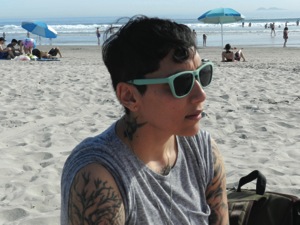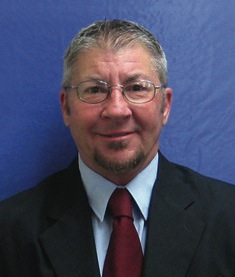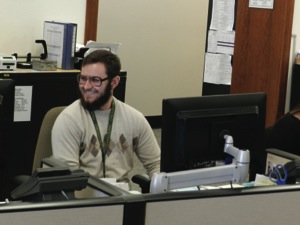
“Every gay person must come out,” Harvey Milk said in his What America Is speech in June 1978. “As difficult as it is, you must tell your immediate family. You must tell your relatives. You must tell your friends if indeed they are your friends. You must tell the people you work with. You must tell the people in the stores you shop in. Once they realize that we are indeed their children, that we are indeed everywhere, every myth, every lie, every innuendo will be destroyed once and all. And once you do, you will feel so much better.” In many ways it’s as true for trans people today as it is was for gay people in 1978.
But, at some point, being out in America isn’t just about creating change with intention, but being true to oneself that’s freeing.
“I’m a domestic violence and sexual assault prevention educator,” Liat Wexler told me at his office in El Cajon at the Center for Community Solutions (CCS). With a genderqueer identity, them’s pronouns are they/them/theirs.
“I’m completely out to everybody at work, and I train everybody at work – trans identity, genderqueer identity, non-binary folks. Most of the people at work from the get go were using my pronouns correctly.”
Genderqueer, gender nonbinary identities are visible here in San Diego. “I can’t really avoid not getting looks, for sure.” Fabian Romero told me at the beach near Hotel Del Coronado.” They were visiting from Olympia, Washington.
“I’m visible because I feel I have no other choice. I couldn’t survive in trying to fit or conform to cis standards. It would hurt my soul more than it hurts to get the looks that I get.”

But that isn’t a bad thing. “I’m happiest when I can be myself.
“I’m an admissions counselor,” Fabian added, “so I walk into high schools like this. It’s pretty amazing to see trans high school students come and talk to me about going to college when they wouldn’t talk to anybody else, you know?”
Claire Russell (she/her/hers) volunteers at the Hillcrest Youth Center every Friday night. I visited her at her El Cajon home where she was baking; the rich aroma of artisan bread wafted about as we spoke.
“When interacting with them,” she said, “they’re all queer and trans too, so it’s not a big deal.”
“It feels real natural,” she continued. “You’re trans in an environment where pretty much everyone else is trans, of all these different age ranges. You’ve got to imagine this is more impactful for the youth because they don’t get to go to (*laugh*) bars or whatever all the time or make friends like you do and make friends all the time; they’re pretty much confined to their schools. This is their opportunity, once or twice a week, to actually have connection to the outside world.”
And that’s what sometimes trans people provide to others.

Education is also about colleges, universities and technical schools. Andrea Livingston goes to New School of Architecture and Design in downtown San Diego.
“I just dress as myself and walk around being me and I don’t actually know if they know [at school that] I’m trans,” Andrea said. “I just live my life the way I live my life, and if someone comes up and asks me I tell them, ‘Yeah, I am.’ I’m proud to be trans. I’m not shy about it anymore. It took a while, but particularly on that; to finally be free!”
If you want to go down to The LGBT Center and meet Connor Maddocks, he’s down there working on the Trans Day of Empowerment that’s coming up April 10.
Connor is so out sometimes he forgets one actually has to say so.
“I make the assumption that everybody in this [LGBT] community knows that I’m transgender because I don’t hide it at all. And, about seven months ago, you know, I’ve been in San Diego 12 years, and I’ve been at The Center for nine, and somebody that I have known for probably eight years came up to me and said, ‘Oh my God I didn’t know you were transgender.’ And I’m like, ‘How could you not know that? I mean, everybody like knows that?’ And, I thought we were fairly close as friends and worked together a lot, and they had no clue whatsoever. And that just cracked me up because I just make that assumption that everybody knows. But for F to M’s, you can’t always tell.”
I’ll drop off one of my Trans and Proud buttons for him later this week, I think.

I went to talk to AT Furuya about them’s life, and we ended up talking about 45 minutes about them’s family home that they is moved back into. They’s cleaning it up and repainting; being out this past weekend was spending a bunch of time with a bunch of trans and queer youth that came over and helped clean and paint them’s family home.
Will Oliver Williams had time for me to snap his picture at his office in the County building downtown, but he was busy working. But, his peer staffers knew I was from LGBT Weekly, and knew why I was photographing him – he was being visible.
The trans community in San Diego is vibrant and pretty visible, and being out here in our hometown can be a joyful experience.
But Connor in the end thought of trans visibility in terms of Harvey Milk’s thoughts.
“I’ve been visible since almost the day I transitioned. I think it’s important to let people know we exist, that we’re their neighbors and coworkers and their friends and their acquaintances,” Connor said. “I think that most people don’t know that they do know a trans person because people think we aren’t out enough. And in order for us to have less discrimination and less hatred, people need to know who we are.”












cool article and all!
but they/them pronouns are used like this:
“With a genderqueer identity, their pronouns are they/them/theirs.”
not “With a genderqueer identity, them’s pronouns are they/them/theirs.”
and (not something I saw in the article, just in general) you’d probably say something like “they are” and not “they is.” basically, just as you would use “they” to refer to a rhetorical person or a person you don’t know (which is the current most common use of they as a singular pronoun) is how you would use it here.
I’m so glad someone said this. the article was almost unreadable due to this.
This was so annoying because they used “his office” instead of “their office”